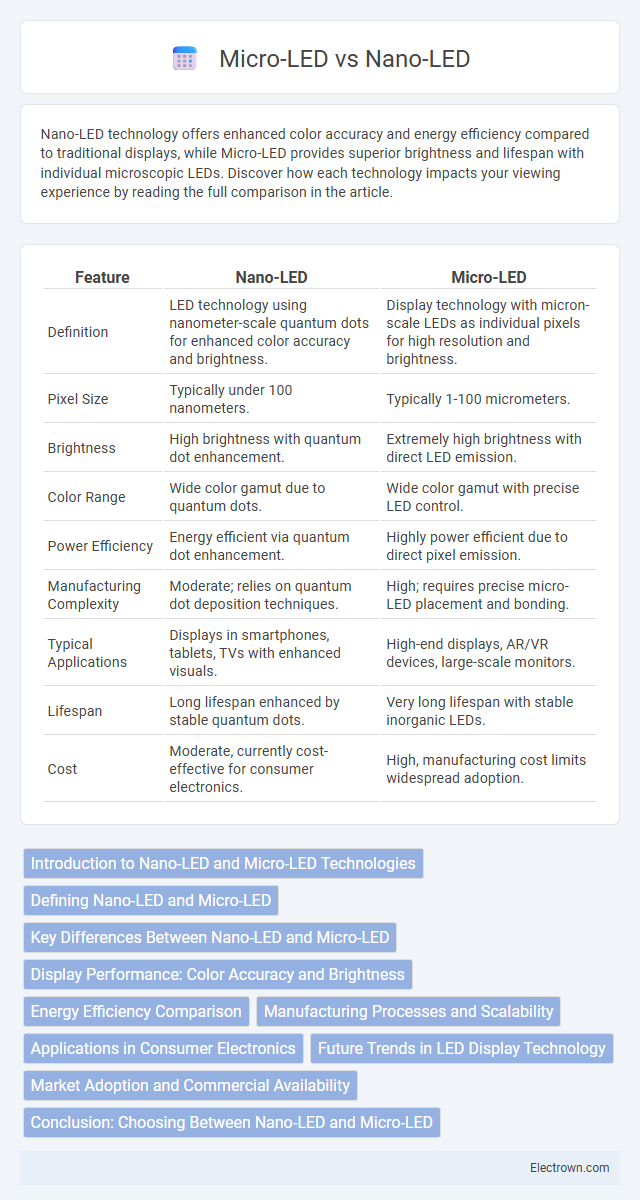Nano-LED technology offers enhanced color accuracy and energy efficiency compared to traditional displays, while Micro-LED provides superior brightness and lifespan with individual microscopic LEDs. Discover how each technology impacts your viewing experience by reading the full comparison in the article.
Table of Comparison
| Feature | Nano-LED | Micro-LED |
|---|---|---|
| Definition | LED technology using nanometer-scale quantum dots for enhanced color accuracy and brightness. | Display technology with micron-scale LEDs as individual pixels for high resolution and brightness. |
| Pixel Size | Typically under 100 nanometers. | Typically 1-100 micrometers. |
| Brightness | High brightness with quantum dot enhancement. | Extremely high brightness with direct LED emission. |
| Color Range | Wide color gamut due to quantum dots. | Wide color gamut with precise LED control. |
| Power Efficiency | Energy efficient via quantum dot enhancement. | Highly power efficient due to direct pixel emission. |
| Manufacturing Complexity | Moderate; relies on quantum dot deposition techniques. | High; requires precise micro-LED placement and bonding. |
| Typical Applications | Displays in smartphones, tablets, TVs with enhanced visuals. | High-end displays, AR/VR devices, large-scale monitors. |
| Lifespan | Long lifespan enhanced by stable quantum dots. | Very long lifespan with stable inorganic LEDs. |
| Cost | Moderate, currently cost-effective for consumer electronics. | High, manufacturing cost limits widespread adoption. |
Introduction to Nano-LED and Micro-LED Technologies
Nano-LED and Micro-LED technologies represent cutting-edge advancements in display innovation, using nanoscale and microscale light-emitting diodes to deliver superior brightness, contrast, and energy efficiency compared to traditional displays. Nano-LEDs utilize quantum dots to emit precise colors with enhanced color accuracy, while Micro-LEDs consist of tiny, self-emissive LEDs that promise higher resolution and longer lifespan. Your choice between these technologies depends on the desired display size, application, and performance requirements.
Defining Nano-LED and Micro-LED
Nano-LEDs are advanced display technologies that utilize nanometer-scale light-emitting diodes for enhanced brightness and color precision, enabling ultra-thin, energy-efficient screens. Micro-LEDs, slightly larger at the micrometer scale, provide superior contrast, faster response times, and better durability compared to traditional LEDs by incorporating microscopic LEDs into each pixel. Your choice between Nano-LED and Micro-LED impacts display quality, power consumption, and device form factor.
Key Differences Between Nano-LED and Micro-LED
Nano-LED technology utilizes nanometer-scale light-emitting diodes to produce vibrant colors with enhanced color purity and energy efficiency, while Micro-LED consists of microscopic LEDs capable of delivering superior brightness, contrast, and longer lifespan. Your choice between Nano-LED and Micro-LED depends on priorities such as display size, resolution, and application, with Micro-LED excelling in large-format displays and Nano-LED suited for compact, high-color-accuracy screens. Key differences include pixel density, manufacturing complexity, and power consumption, making each technology uniquely advantageous in various consumer electronics and professional display markets.
Display Performance: Color Accuracy and Brightness
Nano-LED displays deliver enhanced color accuracy through superior quantum dot technology, offering vibrant and precise color reproduction across a wider color gamut. Micro-LED displays outperform in brightness capabilities, achieving higher peak luminance levels without compromising color fidelity or image uniformity. Both technologies improve display performance significantly, but Micro-LED stands out for exceptional brightness, while Nano-LED excels in producing richer color accuracy.
Energy Efficiency Comparison
Nano-LED displays offer improved energy efficiency over traditional LEDs by utilizing smaller, more precise light sources that reduce power consumption and heat generation. Micro-LED technology surpasses Nano-LEDs in energy efficiency due to its ability to emit pure, self-emissive light with minimal energy loss, enhancing brightness and color accuracy while consuming less power. Your choice between Nano-LED and Micro-LED will significantly impact energy savings, with Micro-LEDs typically providing superior performance for longer battery life in portable and high-resolution displays.
Manufacturing Processes and Scalability
Nano-LED technology involves the integration of nanoscale LEDs through bottom-up synthesis methods, offering potential for simpler fabrication but facing challenges in precise placement and uniformity across large substrates. Micro-LED manufacturing relies on top-down semiconductor processes, including photolithography and mass transfer techniques, which enable high-resolution displays but require complex, expensive equipment and pose scalability hurdles. While Nano-LEDs promise cost-effective scalability due to less intricate fabrication, Micro-LEDs benefit from mature semiconductor manufacturing infrastructure, making large-scale production feasible but currently more capital-intensive.
Applications in Consumer Electronics
Micro-LED technology offers superior brightness, energy efficiency, and lifespan compared to Nano-LEDs, making it ideal for next-generation consumer electronics like smartwatches, AR glasses, and high-end TVs. Nano-LEDs excel in flexible displays and wearable devices due to their smaller pixel size and enhanced color accuracy, improving your visual experience on compact screens. Both display types drive innovation in consumer electronics by delivering sharper images and more durable screens tailored to diverse usage scenarios.
Future Trends in LED Display Technology
Nano-LED and Micro-LED display technologies are poised to revolutionize the future of visual screens with unprecedented brightness, color accuracy, and energy efficiency. Micro-LEDs, characterized by microscopic LEDs that enable higher pixel density and scalability, are gaining traction for large-format displays and augmented reality devices. Nano-LEDs offer potential breakthroughs in quantum dot integration, pushing the boundaries of color gamut and contrast ratio for next-generation ultra-high-definition displays.
Market Adoption and Commercial Availability
Micro-LED technology is gaining traction in premium display markets due to its superior brightness, color accuracy, and energy efficiency compared to Nano-LEDs, but its high manufacturing costs limit widespread commercial availability. Nano-LEDs, leveraging quantum dot enhancements, offer a more affordable solution with better color performance than traditional LEDs, yet they are still emerging in mainstream consumer products. Your choice between these technologies will depend on balancing cutting-edge display quality with current market access and budget considerations.
Conclusion: Choosing Between Nano-LED and Micro-LED
Choosing between Nano-LED and Micro-LED hinges on specific application needs such as display size, resolution, brightness, and cost efficiency. Nano-LED technology excels in producing vibrant colors and flexibility, ideal for smaller, portable devices, while Micro-LED offers superior brightness, energy efficiency, and longevity, making it optimal for large-scale, high-performance displays. Evaluating product requirements and budget constraints is essential to determine the most suitable LED technology for a given use case.
Nano-LED vs Micro-LED Infographic

 electrown.com
electrown.com